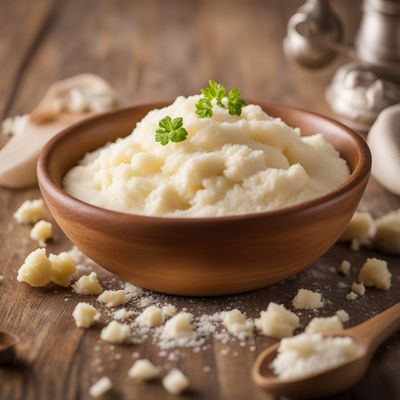
Ingredient
Dried potato products
The Versatile Power of Dehydrated Potatoes
Dried potato products, such as flakes, granules, and powder, are made by dehydrating potatoes to remove their moisture content. This process preserves the flavor, nutrients, and texture of the potatoes, making them a convenient and long-lasting ingredient. Dried potato flakes have a light and fluffy texture, while granules are coarser and retain more of the potato's natural texture. The powder form is finely ground and dissolves easily, making it ideal for thickening soups, sauces, and gravies. These products are often used as a substitute for fresh potatoes in recipes, providing a quick and easy way to add potato flavor and texture to dishes.
Origins and history
The process of drying potatoes dates back centuries and was initially used as a preservation method. Native to the Andes region of South America, potatoes were cultivated by the Incas and played a vital role in their diet. The Spanish conquistadors introduced potatoes to Europe in the 16th century, where they gained popularity due to their versatility and ability to thrive in various climates. The invention of modern dehydration techniques in the 20th century revolutionized the production of dried potato products, making them widely available and accessible.
Nutritional information
Dried potato products are a good source of carbohydrates, providing energy for the body. They also contain essential vitamins and minerals, including vitamin C, potassium, and dietary fiber. A 100-gram serving of dried potato flakes contains approximately 357 calories.
Allergens
Dried potato products are generally allergen-free, but individuals with potato allergies should avoid them.
How to select
When selecting dried potato products, look for packages that are tightly sealed and free from moisture or clumps. Check the expiration date to ensure freshness. Opt for reputable brands known for their quality products.
Storage recommendations
To maintain the freshness and quality of dried potato products, store them in a cool, dry place in airtight containers. Avoid exposure to moisture, as it can cause clumping and spoilage.
How to produce
Amateur gardeners can grow potatoes by planting seed potatoes in well-drained soil and providing adequate sunlight and water. Harvest the potatoes when the plants have died back, and then wash, peel, and slice them. To dehydrate, use a food dehydrator or an oven set to a low temperature until the potatoes are completely dry.
Preparation tips
To rehydrate dried potato flakes, simply add boiling water or milk and let them sit for a few minutes until they absorb the liquid and become fluffy. Dried potato granules can be rehydrated in the same way but may require a slightly longer soaking time. Dried potato powder can be used as a thickening agent in soups, stews, and sauces by whisking it into the liquid until smooth. Experiment with adding herbs, spices, or cheese to enhance the flavor of dishes made with dried potato products.
Substitutions
Fresh potatoes can be used as a substitute for dried potato products, but the texture and cooking time may vary. Mashed potatoes or potato starch can also be used as alternatives for thickening purposes.
Culinary uses
Dried potato products are commonly used to make mashed potatoes, potato pancakes, gnocchi, and potato bread. They can also be added to soups, stews, and casseroles to provide a creamy texture and enhance the flavor. Additionally, dried potato flakes can be used as a coating for fried foods or as a binder in meatloaf and meatballs.
Availability
Dried potato products are widely available in grocery stores, supermarkets, and online retailers worldwide.



